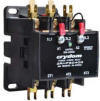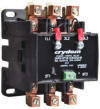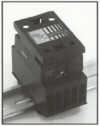HeatersPlus.com Questions? 1-800-442-2581 |
Our secure online ordering website: www.MorElectricHeating.com.
|
|
| Home | Ordering | Contact Us | Heaters | Controls | Accessories | Search | ||
HeatersPlus.com Questions? 1-800-442-2581 |
Our secure online ordering website: www.MorElectricHeating.com.
|
|
| Home | Ordering | Contact Us | Heaters | Controls | Accessories | Search | ||
Replacement/Crossover of Mercury Relay Contactors
 |
Crydom 3RHP Series, AC Input, 3 Phase Hybrid Solid State Contactor, 40-50 Amp Output, (280 or 600 VAC (A replacement for Mercury). Solid state and mechanical switching technologies are combined to provide the performance advantages of both technologies in the industry standard DP contactor package. |
 |
Crydom 3RHP Series, DC Input, 3 Phase Hybrid Solid State Contactor, 40-50 Amp Output, (120 or 240 VAC) (A replacement for Mercury). Solid state and mechanical switching technologies are combined to provide the performance advantages of both technologies in the industry standard DP contactor package. |
 |
Crydom 1RHP Series, AC or DC Input, 1 Phase Hybrid Solid State Phase Contactor, 20 Amp Output, (90-250 VAC) (A replacement for Mercury). Solid state and mechanical switching technologies are combined to provide the performance advantages of both technologies. No heat sink required, DIN rail mount. |
 |
HBControls Solid State Relay and Heat Sink Assemblies. Convenient DIN rail mounting configuration, finger-safe covers and utilize the highest quality relays available. |
 |
Chromalox 4003 DIN-Rail Mount Three Phase Power Controller. (A replacement for Mercury Contactors/Relays), Three Phase Loads up to 60 Amps, 575 Vac, 9-35 Vdc, 100-240 Vac or 24 Vac Input Signals, Easy DIN-Rail or Sub-Panel Installation, Size Compatible for Easy Replacement of Mercury Displacement Relays, Optional Integral Heatsink Thermostat. |
|
Crossovers from DuraKool Mercury Relays |
||||
| DuraKool Part # | Description | HBControls Item ID #'s | HBControls Part # | HBControls Series |
| 1035A120AC | (Coil Voltage: 120 volts AC - 1 Pole - Normally Open - 35 Amp) |
HBC10112 HBC10120 |
HBC-690CHAA
(DIN Rail Mount) HBC-690CHAA-PM (Panel Mount Option) |
40 Amp Single Pole 90-280Vac Control |
| 2035A120AC | (Coil Voltage: 120 volts AC - 2 Pole - Normally Open - 35 Amp) |
HBC10111 HBC10129 |
HBC-690CHAA-2 (DIN Rail Mount) HBC-690CHAA-2-PM (Panel Mount Option) |
40 Amp 3ph/2pole 90-280Vac Control |
| 3035A120AC | (Coil Voltage: 120 Volts AC - 3 Pole Normally Open - 35 Amp) |
HBC10116 HBC10126 |
HBC-690CHAA-3 (DIN RAIL MOUNT) HBC-690CHAA-3-PM (Panel Mount Option) |
40 Amp 3ph/3pole 90-280Vac Control |
| 1035A24AC | (Coil Voltage: 24 Volts AC - 1 Pole Normally Open - 35 Amp) |
HBC10131 HBC10130 |
HBC-50HAL-E (Din Rail Mount) HBC-50HAL-E-PM (Panel mount) |
40 AMP Single Pole 24VAC Control |
| 2035A24AC | (Coil Voltage: 24 Volts AC - 2 Pole Normally Open - 35 Amp) |
HBC10132 HBC10133 |
HBC-50HAL-2-E
(DIN Rail Mount) HBC-50HAL-2-E-PM (Panel Mount) |
40 AMP Double Pole 24VAC Control |
| 3035A24DC | (Coil Voltage: 24 Volts DC - 3 Pole Normally Open - 35 Amp) |
HBC10135 HBC10134 |
HBC-690CHDA-3 (DIN Rail Mount) HBC-690CHDA-3-PM (Panel Mount) |
40 Amp 3ph/3pole 4-32VDC Control |
| 2060APS120AC | (Coil Voltage: 120 volts AC - 2 Pole - Normally Open - 60 Amp) | HBC10123 | HBC-90AF2B (standard Panel Mount with 120V Fan) | 80 Amp 3ph/2pole 90-280V Control |
| 3060APS120AC | (Coil Voltage: 120 volts AC - 3 Pole - Normally Open - 60 Amp) | HBC10125 | HBC-90AF3B (standard Panel Mount with 120V Fan) | 80 Amp 3ph/3Pole 90-280Volt Control |
Crydom Hybrid Solid State Contactors
Solid State Relays and Contactors (SSRs) have been available in one form or the other for over 40 years. Traditional Electromechanical Relays and Contactors (EMRs) as well as Mercury Displacement Relays and Contactors (MDRs) have been available even longer. However, current Environmental regulations now make the future use of Mercury Contactors problematic, and Electro Mechanical Contactors may not offer the required life expectancy or operational characteristics to be suitable replacements for MDRs. Crydom, a world class supplier of Solid State Relays and Controls, has introduced the 3RHP family of Hybrid Solid State Contactors to address this market need for both existing applications and new designs. The 3RHP’s hybrid technology combines the benefits of both SSR and EMR technologies in a unique approach resulting in a Hybrid Solid State Contactor with ratings of up to 50Amps @ 600VAC.
What is a Hybrid Solid State Contactor?
Crydom has combined solid state and mechanical switching technologies to create its line of Hybrid Solid State Contactors. The RHP contactors (patent pending) provide the performance advantages of both technologies in an industry standard DP contactor package. Crydom’s proven Hybrid SSR technology utilizes contactless solid state turn on and turn off performance, coupled with the very low on state power dissipation characteristic of contactors. This combination results in a fast switching highly reliable contactor that does not require the use of a heat sink.
Available in single and 3 phase versions, Hybrid Solid State Contactors are a cost effective alternative to Mercury Displacement Relays (MDR). RHP contactors are safe and comply with industry standards while offering high power switching capabilities.
What are the advantages of the RHP contactors?
They are the perfect “mercury-free alternative” to replace MDRs
40 & 50 Amp versions in an industry standard DP contactor package for easy replacement in existing applications
Highly reliable and longer operation life than standard EMRs
DC logic compatible input available
No heat sink requirement reduces panel space and overall system cost
Crydom combined solid state and mechanical switching technologies to create its line of Hybrid Solid State Contactors:
The Hybrid Contactor (3RHP) offers the following advantages:
Mercury and Mechanical Vs. Solid State Relays:
Mercury: Solid state: EMR:
Contains no
mercury
No Yes Yes
Provide air gap
isolation:
Yes No Yes
Photo-coupled isolation of input to output
No Yes No
Can accommodate high inrush well
Yes Yes No
Does not have
arcing
Yes Yes No
Quiet
operation
Yes Yes No
Silent
operation
No Yes No
Environmentally
friendly
No Yes Yes
Can be mounted at any angle
No Yes Yes
Does not produce heat or require a heat sink
Yes No Yes
Available as a hybrid
No Yes Yes
Can be used in hazardous environments
Yes Yes Yes
Extremely fast
switching No
Yes No
Is well suited for proportional power control
No Yes No
Can be used for phase angle control
No Yes No
Can be exported to other countries easily
No Yes Yes
RoHS
No Yes Yes
Millions of
operations
Yes Yes No
Billions of operations
No Yes No
Contains no moving
parts
No Yes No
Little to no leakage current/voltage w/o snubber
Yes Yes Yes
Has input currents as low as 2 mA
No Yes No
Has no inrush on input terminals
No Yes No
Current limited control input available
No Yes No
Fast switching
time
No Yes No
Easily disposed
of
No Yes Yes
Consumes minimal power, Input side
No Yes No
Consumes minimal power, output side
Yes Yes Yes
Consumes no power on output side
Yes No Yes
Can be used in variable power applications to save energy
No Yes No
Risk of fines due to improper handling and disposal
Yes No No
Universal acceptability
globally No
Yes Yes
Easily compatible with industrial control components
No Yes Yes
Finger safe
operation
No Yes Yes
We are frequently asked to recommend our solid-state relay assembly in replacement of a mercury or electromechanical relay or contactor. Often the only application information provided is the contact rating of the relay currently being used, while this information is helpful it is incomplete. It is imperative that the actual load being controlled, and the ambient operating temperature is known when applying a solid-state relay.
Solid-state relays, unlike mercury or electromechanical relays, do not have moving parts which wear out due to mechanical wear over a finite number of operations, theoretically, when properly applied, they infinite life. It is important therefore, that in addition to the current and voltage all characteristics of the load are considered. Is the load resistive or inductive, AC or DC, three phase or single phase. If three phase, are all three or only two legs being controlled, is the circuit Delta or Y? A major enemy of the solid-state relay and often the cause of premature failure is heat, when the relay is switching a load it is generating an amount of heat proportional to the wattage of that load.
When replacing a mercury or electromechanical relay with a solid state relay make sure that you have determined the actual load being switched as well as the ambient temperature of the environment in which the relay is being operated. Generally, if the load is greater than 10 amperes AC and the ambient temperature is greater than 20 degrees centigrade the relay must be mounted on an appropriately sized heat sink, or another method of directing heat away from the relay utilized. In the case of larger current loads, or a higher ambient temperature, both a heat sink and cooling fan may be required to direct heat away from the assembly.
HBControls engineers are well versed in the practice of determining the appropriate combination of solid-state relay and heat dissipating devices.
|
|||||||||||||||||||||||||||||||||||||||||||||||||||||||||||||||||||||||||||||||||||||||||||||||||||||||||||||||||||||||||||||||||||||||||||||||||||||||||||||||||||||||||||||||||||||||||||||||||||||||||||||||||||||||||||||||||||||||||||||||||||||||||||||||||||||||||||||||||||||||||||||||||||||||||||||||||||||||||||||||||||||||||||||||||||||||||||||||||||||||||||||||||||||||||||||||||||||||||||||||||||||||||||||||||||||||||||||||||||||||||||||||||||||||||||||||||||||||||||||||||||||||||||||||||||||||||||||||||||||||||||||||||||||||||||||||||||||||||||||||||||||||||||||||||||||||||||||||||||||||||||||||||||||||||||||||||||||||||||||||||||||||||||||||||||||||||||||||||||||||||
|
We are a Distributor of Industrial, Commercial and Residential Heaters and Controls. Always consult manufacturers installation instructions for proper installation of the products or systems shown on this website. © Copyright 1999-2019 Mor Electric Heating Assoc., Inc. MOR
ELECTRIC HEATING ASSOC., INC. |
| |